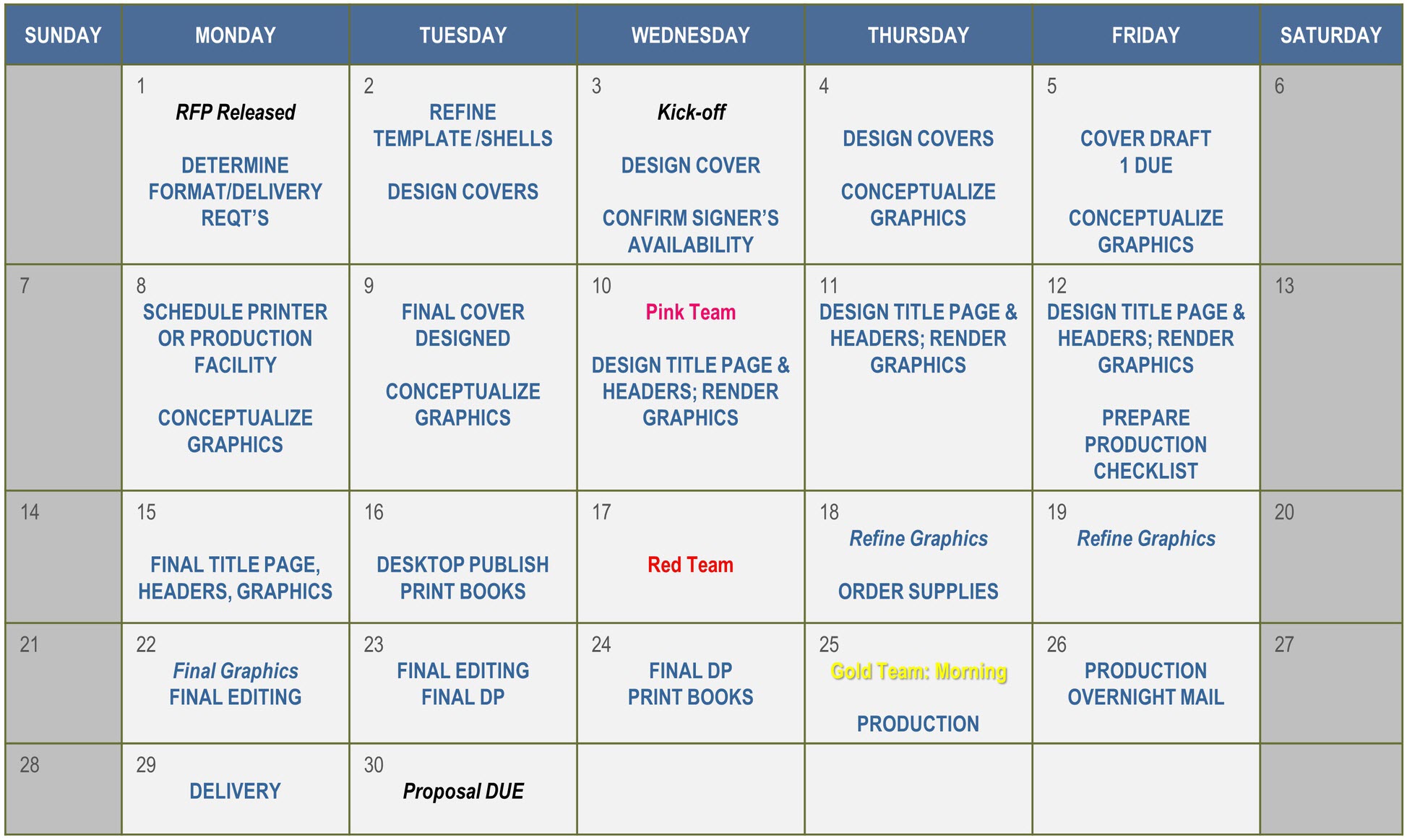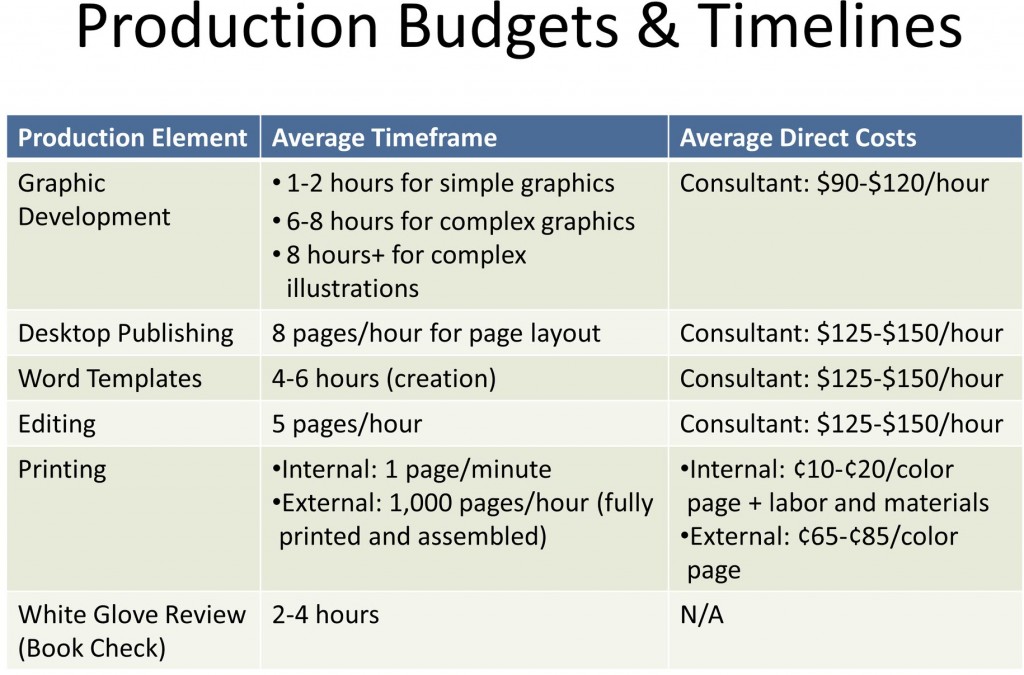Proposal production across the business development life cycle – phase 4 (Part 5 of 6)
In her previous post (Part 4 of 6), Briana Coleman, PPM.APMP discussed the key activities involved in Phase 3 of the typical business development (BD) life cycle:
- Phase 1 Opportunity identification and assessment
- Phase 2 Pursuit
- Phase 3 Pre-proposal preparation
- Phase 4 Proposal development
- Phase 5 Post-submittal
In this post, Briana discusses the key production activities that you should perform in Phase 4 Proposal Preparation.
Once you receive your final RFP, you can begin actually implementing your production plan. Below is a typical 30-day schedule to give you a sense of when you should begin each element of production. You’ll note that final production begins on DAY 1!
By Day 2, you should be able to refine your templates to match the format/delivery requirements of your RFP. Note that I am saying refine, and not develop, because you will have already taken care of baseline templates in your pre-proposal phase. Here, you’ll update fonts and font sizes and develop shells. Shells are Microsoft Word documents containing all of your paragraph styles, headers, and footers—with the actual headings and RFP instructions embedded in the document.
Use the first week to design your cover as well. Your production plan may dictate a standard cover that you will use; however, even standard covers should be able to be tailored to each client. Use this first week to design or tweak the cover—and have it ready for review at Pink Team. Once you get approval at Pink Team, you can design or refine your spines, title pages, headers, footers, and CD labels to coordinate with the main cover.
Work on graphic conceptualization in the first week, after you’ve assigned sections to authors at kick-off. Stop spending money on rendering graphics until they are fully conceptualized and blessed! Spend time up front actually conceptualizing the graphics and vetting them in Pink Team. Only after the graphics are vetted and authors have received content suggestions in Pink Team should you take the time to render your graphics.
By the beginning of week 2, schedule your printer and production facility. If you are using an outside printer, ensure that they are available on your selected printing days—and get yourself on their calendars early. This will ensure you are a priority for them when the job comes around. If you are printing in-house, ensure that the company as a whole knows when you intend to print. This is particularly important for larger corporations with multiple proposal teams that may be fighting for valuable resources simultaneously.
By week 3, you can begin desktop publishing your proposal. I always save a full day before Red Team to rough desktop publish the books and produce the books in hard copy. It can be distracting to desktop publish for Pink Team—you want people to worry about content in Pink Team. But by Red Team, you need to ensure that you are within page count, the design doesn’t offend anybody on the review panel, and the direction is the right one.
Post-Red Team, you are really only giving your authors a couple of days to fix whatever needs changing prior to Gold Team. Post-Red Team is not the time to completely rewrite your proposal. Instead, have the authors work with the graphic artists to finalize the graphics, get their content within page count, and ensure compliance.
Now comes the controversial part of the schedule—the part that usually is left to the last 24 hours before a proposal is due, if it’s done at all. That’s the final editing and desktop publishing.
Assuming you have different people doing editing and desktop publishing, start with editing. Give your editor a full 1.5 days to edit the entire proposal—all volumes, covers, footers, everything. You may have to allow for even more time depending on the size of the proposal. After the editor is done, complete final desktop publishing.
Here is where you make every page sing and the content pop. Ideally, the editor and desktop publisher should work closely together—because you may find yourself slightly over page count after desktop publishing. A good desktop publisher has tricks to get extra lines on a page, while a good editor can recommend words to cut if the page limits aren’t perfect at the end.
You’ll notice that after Gold Team, we are leaving 2 days for printing and assembly. We are also overnight delivering the proposal 2 days before it’s due. Government offices often have very lengthy processes for receiving packages, and proposals have been known to get stuck in the mail room for a day.
When you put your actual proposal schedule together, keep in mind these facts about how long a production element takes and how much it will cost if you use outside help.
While we all think about when to schedule Red Team and how long an author needs to write, we often forget about production details when putting together our master schedule. Use these tips, and you’ll find yourself well-prepared when delivery day comes around!
What key production activities do you perform in Phase 4 Proposal Preparation? Send your thoughts to me at BWingate@LohfeldConsulting.com, and I’ll share your advice in upcoming posts!
Paperback or Kindle
10 steps to creating high-scoring proposals
by Bob Lohfeld
contributors Edited by Beth Wingate
Subscribe to our free ebrief
Teaming friends, frenemies, and enemies—12 tips to mitigate harmful effects
Did you know that contracting officers spend up to 20% of their time mitigating disputes between teaming partners? In an informal poll we conducted on LinkedIn last month, 40% of respondents classified their teaming partners as “frenemies” on their last bid.
Explore Further
- Advice (445)
- AI (5)
- APMP (17)
- Business Development (197)
- Capture Management (196)
- Favorite Books (5)
- Go-to-Market (27)
- Graphics (6)
- Lohfeld Books (3)
- Past Performance (58)
- Post-submission Phase (15)
- Pre-RFP Preparation (210)
- Proposal Management (269)
- Proposal Production (60)
- Proposal Reviews (27)
- Proposal Writing (77)
- Pursuit Phase (89)
- Research Report (2)
- Resources (60)
- Tools & Tips (258)
- Training (10)
- Uncategorized (220)

Sign Up for INSIGHTS and Download your FREE book
We'd love to help you with your proposals. Enjoy our complimentary Lohfeld Consulting Group Capture & Proposal Insights & Tips book with your FREE subscription to our Insights Newsletter.
GET YOUR FREE BOOK






